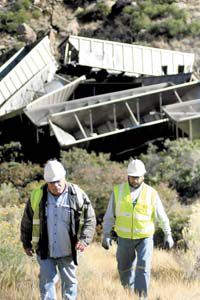| Union Pacific representative see 18 derailed coal cars for the first time Tuesday morning. Since the incident the UP has been moving equipment around the clock to return service to both lines affected by the cars. |
A total of 18 coal cars derailed at approximately 10:15 a.m. on Sept. 25.
All 18 cars, which came off the track approximately six miles north of Helper, were owned by the Union Pacific Railroad.
No injuries or chemical spills occurred during the incident according to UP director for media information James Barnes.
“The cause of the accident is still under investigation,” said Barnes. “And we don’t consider the incident a collision as there was no locomotive impact.”
According to the UP spokesman, seven loaded coal cars initially derailed while traveling west bound on main track one.
The railroad cars were en route to Kentucky from Utah.
The train was 107 cars long and according to an on-site UP employee each loaded car weighs in excess of 250,000 pounds.
“We have not determined why or how, but the initial seven cars caused 11 additional empty rail cars to come off the track,” explained Barnes.
The 11 empty railroad cars were traveling east bound on the outside main track two. The outside two rails run parallel to the number one track.
“We have had crews on the scene around the clock since the time of the accident,” said Barnes. “We expect to have rail service returned to main number two on the morning of the Sept. 26 and we will keep working around the clock until we return service to main number one.”
Barnes has been the railroad company’s spokesperson since November 2006. He is responsible for program development within the organization as well as being the main media contact for Union Pacific.
“These incidents do occur,” said Barnes. “What is important is our response, our commitment to restoring service as quickly and safely as possible.”
According to Union Pacific information, the railroad began while it was still common for many travelers to walk alongside wagons across the Great Plains to California and Oregon – a journey that could take six months.
“It is not small wonder then, that America had railroad fever in the 19th century,” points out the UP website. “The national imagination was propelled by the very real, albeit intimidating, prospect of building a railroad that joined east and west.”
Only trails existed for wagons crossing before the transcontinental.
According to the Union Pacific website bridging the wilderness with rails took six years and an army of 20,000 men, primarily immigrants from China and Europe, to complete.
“It took brute human effort, as the building was done entirely by hand,” commented the site. “To this day, no one knows how many died in the effort, or what it really cost.”
The railroad was considered the key to westward expansion and the future of the country, according to UP information. A transcontinental route would reduce the time it took to cross the continent and develop the nations interior.
The United States Congress determined that a route running from the east to California would also be essential to national defense.
The route was debated in Congress, with people from the south lobbying for a southern route and Americans from the north lobbying for a northern path. Ultimately, a northern route following the Platte River was chosen.
The Pacific Railroad Act of 1862 made construction of the transcontinental railroad possible. It designated tasks to separate companies: the Central Pacific Railroad of California was to build eastward from Sacramento and the new Union Pacific was to build westward up the Platte River Valley from Omaha, Neb.
The railroad was completed on May 10, 1869 with a golden spike driven at Promontory Point.
The completion of the railroad tracks made it possible to travel across the entire continent in 10 days.

